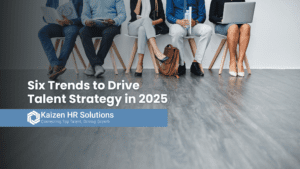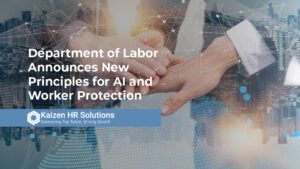As workplace priorities have shifted over the past few years, women have found themselves with new opportunities to celebrate and new challenges to manage. Just like any employee, women are looking for core elements such as career development, work-life balance, and a sense of belonging. To better understand how to attract and retain high-performing women, let’s consider a few of the top priorities for working women in today’s world.
Career Development Takes Priority
Research by Gartner reveals that employee experience and career development are among many organizations’ top focuses in 2023, with 47% of HR leaders saying they’re prioritizing these factors. Emphasizing long-term career pathing can be a key factor in setting organizations apart in a tight labor market, both in terms of attracting and retaining talent and in terms of overall performance. One report found that fewer than 20% of low-performing teams prioritize clear career growth paths, but 60% of high-performing teams do.
Women often find that career paths, especially the road to leadership roles, are more difficult compared to those of their male colleagues. According to research from McKinsey and LeanIn, women lose out at the “first rung” on the leadership ladder or first-step management roles. For every 100 men who are promoted to manager positions, only 87 women are promoted, and only 82 women of color are promoted. This creates a pipeline problem at higher levels, which makes it harder to recruit lower-level women who are interested in career development.
Even once they ascend to leadership roles, high-performing women often struggle to “prove themselves,” assert authority, and continue to move up the career ladder. They are still more likely to have colleagues imply they are unqualified for their roles or be mistaken for someone junior. This, combined with a general sense of frustration over career development opportunities, can create an environment of greater stress and, if organizations don’t actively work to combat these issues, greater turnover. Given these circumstances, women in leadership are leaving their companies at a rate of 10.5%, the highest in years and a serious talent drain in a competitive labor market.
These challenges are exacerbated for women of color, LGBTQ+ women, and women with disabilities, all of whom report increased instances of microaggressions, demeaning behavior towards them, and a lack of support for their advancement. And any of these issues, alone or in combination, may be enough to block women on their intended career paths. As a result, women are prioritizing companies that have clear, concrete support for career development and an understanding of how this can look different for women. This could mean investment in mentorship programs or affinity groups, excellent family leave policies, and a robust HR function to address both large-scale, cultural concerns as well as individual conflicts.
Well-Being and DEI Are Connected
While diversity, equity, inclusion, and belonging have certainly become more of a focus in recent times, they’re also inextricably linked with overall well-being. Having the space to be your most authentic self has a positive impact, while feeling like you have to suppress part of yourself will have far-reaching effects. As a result, underrepresented groups are prioritizing roles and organizations that also understand the connection between well-being and DEI efforts.
The statistics are clear: addressing these issues must be a priority, or talent will exit. McKinsey reports that 17% of women leaders who have left their jobs in the past two years cited an organization’s commitment to well-being as a reason to seek a new position, with young women saying this at especially high rates. The same study found that 40% of women leaders say the work they do on DEI isn’t formally acknowledged and rewarded, and 43% report feeling burned out (compared with 31% of male leaders at the same level).
DEI work requires extra effort, both in terms of actual “work” and in terms of the emotional and mental toll it can take, particularly when organizations lack a strong commitment to implementation. Even women who believe strongly in the importance of their work may wind up leaving if it’s detrimental to their well-being and if they lack support and adequate compensation.
Remote vs. Flexible Work
Hybrid and remote work have been the big buzzwords over the past few years, but there’s more than meets the eye to these concepts. While the main conflict has been centered on the contrast between “return to office” and “work from home,” there’s another complicated reality that has particularly affected women.
To be clear, remote and hybrid work is generally popular, and it can even serve to reduce some of the stressors that women face in the workplace. One Gallup survey found that approximately 60% of remote-capable employees prefer a long-term hybrid work arrangement. Many women have also reported that hybrid work has helped to reduce instances of experiencing microaggressions, particularly towards women of color, LGBTQ+ women, and women with disabilities. 71% of HR leaders, meanwhile, believe that the rise in remote work has actually helped their organizations diversify by opening more doors to more individuals.
Remote and hybrid work, on their own, can actually heighten problems as well, particularly when the already-gendered discrepancies in work recognition are worsened by employees not being literally “in front of” leaders. This is why flexibility, not pure remote and hybrid arrangements, is a top priority for women in the workplace. Women who can control working how they want are 20% more likely to be happy with their jobs (81% versus 61% of those without control over their work arrangements) and feel like they have equal opportunities (67% versus 47%).
Attracting and retaining women in today’s workplaces, particularly those interested in leadership roles, requires a well-rounded approach to crafting policies that take into account each group’s unique concerns. It may be tempting to just craft a broad policy and attempt to apply it to everyone “equally,” but as we know from DEI work, “equal” isn’t always equitable. As the labor market continues to be competitive, it’s more important than ever for organizations to directly address women’s top priorities, allowing these companies to diversify, build reputation, and to ensure that top talent will remain in place to help the organizations grow and thrive for years to come.
By Rose Dorta

Are you a high-performing leader or believe you have the potential to tackle a more challenging role? Would you be interested in career opportunities that are seeking these attributes?
I’d love to chat with you and answer any questions that you have. Email me, Rose Dorta, Managing Director of Kaizen HR Solutions, here.







